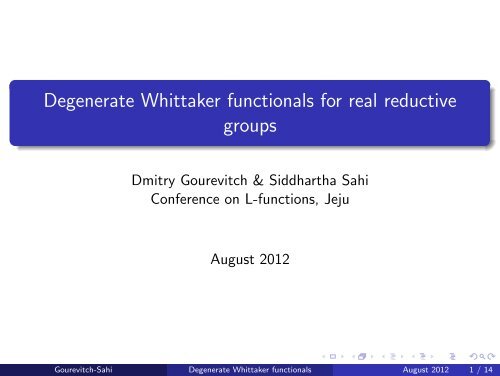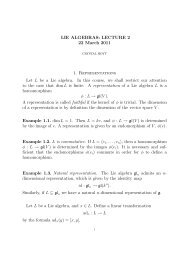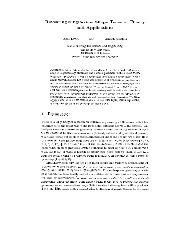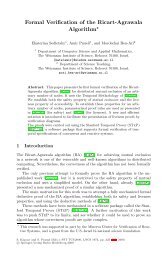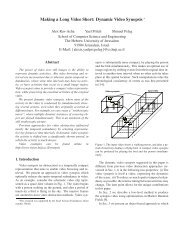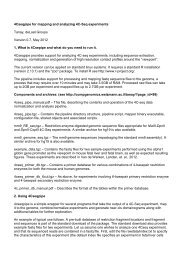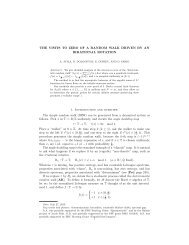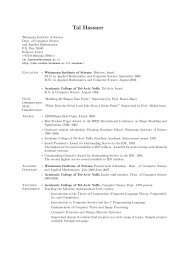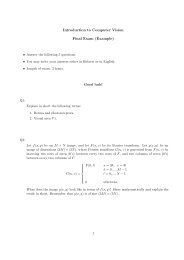Degenerate Whittaker functionals for real reductive groups
Degenerate Whittaker functionals for real reductive groups
Degenerate Whittaker functionals for real reductive groups
Create successful ePaper yourself
Turn your PDF publications into a flip-book with our unique Google optimized e-Paper software.
<strong>Degenerate</strong> <strong>Whittaker</strong> <strong>functionals</strong> <strong>for</strong> <strong>real</strong> <strong>reductive</strong><br />
<strong>groups</strong><br />
Dmitry Gourevitch & Siddhartha Sahi<br />
Conference on L-functions, Jeju<br />
August 2012<br />
Gourevitch-Sahi <strong>Degenerate</strong> <strong>Whittaker</strong> <strong>functionals</strong> August 2012 1 / 14
<strong>Whittaker</strong> <strong>functionals</strong><br />
F: local field of char.0, G: <strong>reductive</strong> group over F.<br />
Gourevitch-Sahi <strong>Degenerate</strong> <strong>Whittaker</strong> <strong>functionals</strong> August 2012 2 / 14
<strong>Whittaker</strong> <strong>functionals</strong><br />
F: local field of char.0, G: <strong>reductive</strong> group over F.<br />
M(G ): smooth admissible representations (of moderate growth).<br />
Gourevitch-Sahi <strong>Degenerate</strong> <strong>Whittaker</strong> <strong>functionals</strong> August 2012 2 / 14
<strong>Whittaker</strong> <strong>functionals</strong><br />
F: local field of char.0, G: <strong>reductive</strong> group over F.<br />
M(G ): smooth admissible representations (of moderate growth).<br />
Assume G quasisplit: fix Borel B = HN, n := Lie F (N).<br />
Define<br />
n ′ = [n, n] , v = n/n ′ , Ψ = v ∗ ⊂ n ∗<br />
Gourevitch-Sahi <strong>Degenerate</strong> <strong>Whittaker</strong> <strong>functionals</strong> August 2012 2 / 14
<strong>Whittaker</strong> <strong>functionals</strong><br />
F: local field of char.0, G: <strong>reductive</strong> group over F.<br />
M(G ): smooth admissible representations (of moderate growth).<br />
Assume G quasisplit: fix Borel B = HN, n := Lie F (N).<br />
Define<br />
n ′ = [n, n] , v = n/n ′ , Ψ = v ∗ ⊂ n ∗<br />
Ψ ←→ Lie algebra characters of n ←→ unitary group characters of N<br />
Gourevitch-Sahi <strong>Degenerate</strong> <strong>Whittaker</strong> <strong>functionals</strong> August 2012 2 / 14
<strong>Whittaker</strong> <strong>functionals</strong><br />
F: local field of char.0, G: <strong>reductive</strong> group over F.<br />
M(G ): smooth admissible representations (of moderate growth).<br />
Assume G quasisplit: fix Borel B = HN, n := Lie F (N).<br />
Define<br />
n ′ = [n, n] , v = n/n ′ , Ψ = v ∗ ⊂ n ∗<br />
Ψ ←→ Lie algebra characters of n ←→ unitary group characters of N<br />
Ψ ⊃ Ψ × := non-degenerate characters.<br />
Gourevitch-Sahi <strong>Degenerate</strong> <strong>Whittaker</strong> <strong>functionals</strong> August 2012 2 / 14
<strong>Whittaker</strong> <strong>functionals</strong><br />
F: local field of char.0, G: <strong>reductive</strong> group over F.<br />
M(G ): smooth admissible representations (of moderate growth).<br />
Assume G quasisplit: fix Borel B = HN, n := Lie F (N).<br />
Define<br />
n ′ = [n, n] , v = n/n ′ , Ψ = v ∗ ⊂ n ∗<br />
Ψ ←→ Lie algebra characters of n ←→ unitary group characters of N<br />
Ψ ⊃ Ψ × := non-degenerate characters.<br />
For ψ ∈ Ψ, π ∈ M(G ) define<br />
Wh ∗ ψ(π) := Hom cts<br />
N (π, ψ), Ψ(π) := {ψ ∈ Ψ : Wh ∗ ψ(π) ̸= 0}<br />
Gourevitch-Sahi <strong>Degenerate</strong> <strong>Whittaker</strong> <strong>functionals</strong> August 2012 2 / 14
<strong>Whittaker</strong> <strong>functionals</strong><br />
F: local field of char.0, G: <strong>reductive</strong> group over F.<br />
M(G ): smooth admissible representations (of moderate growth).<br />
Assume G quasisplit: fix Borel B = HN, n := Lie F (N).<br />
Define<br />
n ′ = [n, n] , v = n/n ′ , Ψ = v ∗ ⊂ n ∗<br />
Ψ ←→ Lie algebra characters of n ←→ unitary group characters of N<br />
Ψ ⊃ Ψ × := non-degenerate characters.<br />
For ψ ∈ Ψ, π ∈ M(G ) define<br />
Wh ∗ ψ(π) := Hom cts<br />
N (π, ψ), Ψ(π) := {ψ ∈ Ψ : Wh ∗ ψ(π) ̸= 0}<br />
(Casselman) For any ψ ∈ Ψ × ,<br />
π ↦→ Whψ ∗ (π) is an exact functor.<br />
Gourevitch-Sahi <strong>Degenerate</strong> <strong>Whittaker</strong> <strong>functionals</strong> August 2012 2 / 14
<strong>Whittaker</strong> <strong>functionals</strong><br />
F: local field of char.0, G: <strong>reductive</strong> group over F.<br />
M(G ): smooth admissible representations (of moderate growth).<br />
Assume G quasisplit: fix Borel B = HN, n := Lie F (N).<br />
Define<br />
n ′ = [n, n] , v = n/n ′ , Ψ = v ∗ ⊂ n ∗<br />
Ψ ←→ Lie algebra characters of n ←→ unitary group characters of N<br />
Ψ ⊃ Ψ × := non-degenerate characters.<br />
For ψ ∈ Ψ, π ∈ M(G ) define<br />
Wh ∗ ψ(π) := Hom cts<br />
N (π, ψ), Ψ(π) := {ψ ∈ Ψ : Wh ∗ ψ(π) ̸= 0}<br />
(Casselman) For any ψ ∈ Ψ × ,<br />
π ↦→ Whψ ∗ (π) is an exact functor.<br />
Theorem (Gelfand-Kazhdan, Shalika)<br />
For π ∈ Irr(G ), ψ ∈ Ψ × , dim Whψ ∗ (π) ≤ 1.<br />
Gourevitch-Sahi <strong>Degenerate</strong> <strong>Whittaker</strong> <strong>functionals</strong> August 2012 2 / 14
Kostant’s theorem<br />
We say π is generic if ∃ψ ∈ Ψ × s.t. Wh ψ (π) ̸= 0.<br />
Gourevitch-Sahi <strong>Degenerate</strong> <strong>Whittaker</strong> <strong>functionals</strong> August 2012 3 / 14
Kostant’s theorem<br />
We say π is generic if ∃ψ ∈ Ψ × s.t. Wh ψ (π) ̸= 0.<br />
Theorem (Kostant, Rodier)<br />
π is generic iff it is large.<br />
Gourevitch-Sahi <strong>Degenerate</strong> <strong>Whittaker</strong> <strong>functionals</strong> August 2012 3 / 14
Kostant’s theorem<br />
We say π is generic if ∃ψ ∈ Ψ × s.t. Wh ψ (π) ̸= 0.<br />
Theorem (Kostant, Rodier)<br />
π is generic iff it is large.<br />
Theorem (Harish-Chandra, Howe)<br />
Near e ∈ G, the character distribution (asymptotically) equals to a linear<br />
combination of Fourier trans<strong>for</strong>ms of Haar measures of nilpotent coadjoint<br />
orbits.<br />
χ π ≈ ∑ a O F(µ O )<br />
Gourevitch-Sahi <strong>Degenerate</strong> <strong>Whittaker</strong> <strong>functionals</strong> August 2012 3 / 14
Kostant’s theorem<br />
We say π is generic if ∃ψ ∈ Ψ × s.t. Wh ψ (π) ̸= 0.<br />
Theorem (Kostant, Rodier)<br />
π is generic iff it is large.<br />
Theorem (Harish-Chandra, Howe)<br />
Near e ∈ G, the character distribution (asymptotically) equals to a linear<br />
combination of Fourier trans<strong>for</strong>ms of Haar measures of nilpotent coadjoint<br />
orbits.<br />
χ π ≈ ∑ a O F(µ O )<br />
Define WF(π) = ∪{O | a O ̸= 0} ⊂ N , where N ⊂ g ∗ denotes the<br />
nilpotent cone.<br />
Gourevitch-Sahi <strong>Degenerate</strong> <strong>Whittaker</strong> <strong>functionals</strong> August 2012 3 / 14
Kostant’s theorem<br />
We say π is generic if ∃ψ ∈ Ψ × s.t. Wh ψ (π) ̸= 0.<br />
Theorem (Kostant, Rodier)<br />
π is generic iff it is large.<br />
Theorem (Harish-Chandra, Howe)<br />
Near e ∈ G, the character distribution (asymptotically) equals to a linear<br />
combination of Fourier trans<strong>for</strong>ms of Haar measures of nilpotent coadjoint<br />
orbits.<br />
χ π ≈ ∑ a O F(µ O )<br />
Define WF(π) = ∪{O | a O ̸= 0} ⊂ N , where N ⊂ g ∗ denotes the<br />
nilpotent cone.<br />
π is called large if WF(π) = N .<br />
Gourevitch-Sahi <strong>Degenerate</strong> <strong>Whittaker</strong> <strong>functionals</strong> August 2012 3 / 14
Case of non-generic representations<br />
In the p-adic case, Moeglin and Waldspurger give a very general<br />
definition of degenerate <strong>Whittaker</strong> models and give a precise<br />
connection between their existence and the wave-front set WF(π).<br />
In the <strong>real</strong> case there is no full analog currently.<br />
Gourevitch-Sahi <strong>Degenerate</strong> <strong>Whittaker</strong> <strong>functionals</strong> August 2012 4 / 14
Case of non-generic representations<br />
In the p-adic case, Moeglin and Waldspurger give a very general<br />
definition of degenerate <strong>Whittaker</strong> models and give a precise<br />
connection between their existence and the wave-front set WF(π).<br />
In the <strong>real</strong> case there is no full analog currently.<br />
Several authors (Matumoto, Yamashita, . . . ) consider generalized<br />
<strong>Whittaker</strong> <strong>functionals</strong> ∼ generic characters <strong>for</strong> smaller nilradicals<br />
Gourevitch-Sahi <strong>Degenerate</strong> <strong>Whittaker</strong> <strong>functionals</strong> August 2012 4 / 14
Case of non-generic representations<br />
In the p-adic case, Moeglin and Waldspurger give a very general<br />
definition of degenerate <strong>Whittaker</strong> models and give a precise<br />
connection between their existence and the wave-front set WF(π).<br />
In the <strong>real</strong> case there is no full analog currently.<br />
Several authors (Matumoto, Yamashita, . . . ) consider generalized<br />
<strong>Whittaker</strong> <strong>functionals</strong> ∼ generic characters <strong>for</strong> smaller nilradicals<br />
We consider degenerate <strong>functionals</strong> ∼ arbitrary characters of n.<br />
Gourevitch-Sahi <strong>Degenerate</strong> <strong>Whittaker</strong> <strong>functionals</strong> August 2012 4 / 14
Main results<br />
From now on, let F = R.<br />
Gourevitch-Sahi <strong>Degenerate</strong> <strong>Whittaker</strong> <strong>functionals</strong> August 2012 5 / 14
Main results<br />
From now on, let F = R.<br />
The finite group F G = Norm GC (G ) / (Z GC · G ) acts on M (G ).<br />
Gourevitch-Sahi <strong>Degenerate</strong> <strong>Whittaker</strong> <strong>functionals</strong> August 2012 5 / 14
Main results<br />
From now on, let F = R.<br />
The finite group F G = Norm GC (G ) / (Z GC · G ) acts on M (G ).<br />
For π ∈ M (G ) , define ˜π = ⊕ {π a : a ∈ F G }.<br />
Gourevitch-Sahi <strong>Degenerate</strong> <strong>Whittaker</strong> <strong>functionals</strong> August 2012 5 / 14
Main results<br />
From now on, let F = R.<br />
The finite group F G = Norm GC (G ) / (Z GC · G ) acts on M (G ).<br />
For π ∈ M (G ) , define ˜π = ⊕ {π a : a ∈ F G }.<br />
Theorem (1)<br />
For π ∈ M (G ) we have<br />
Ψ(π) ⊂ WF(π) ∩ Ψ ⊂ Ψ ( ˜π) (1)<br />
Moreover if G = GL n (R) or if G is a complex group then ˜π = π and<br />
Ψ(π) = WF(π) ∩ Ψ (2)<br />
Gourevitch-Sahi <strong>Degenerate</strong> <strong>Whittaker</strong> <strong>functionals</strong> August 2012 5 / 14
Main results<br />
Theorem (2)<br />
The sets Ψ (π) and WF (π) determine one another if<br />
1 G = GL n (R) or GL n (C) or SL n (C) and π ∈ M (G )<br />
Gourevitch-Sahi <strong>Degenerate</strong> <strong>Whittaker</strong> <strong>functionals</strong> August 2012 6 / 14
Main results<br />
Theorem (2)<br />
The sets Ψ (π) and WF (π) determine one another if<br />
1 G = GL n (R) or GL n (C) or SL n (C) and π ∈ M (G )<br />
2 G = Sp 2n (C) or O n (C) or SO n (C) and π is irreducible<br />
Gourevitch-Sahi <strong>Degenerate</strong> <strong>Whittaker</strong> <strong>functionals</strong> August 2012 6 / 14
Main results<br />
Theorem (2)<br />
The sets Ψ (π) and WF (π) determine one another if<br />
1 G = GL n (R) or GL n (C) or SL n (C) and π ∈ M (G )<br />
2 G = Sp 2n (C) or O n (C) or SO n (C) and π is irreducible<br />
Gourevitch-Sahi <strong>Degenerate</strong> <strong>Whittaker</strong> <strong>functionals</strong> August 2012 6 / 14
Main results<br />
Theorem (2)<br />
The sets Ψ (π) and WF (π) determine one another if<br />
1 G = GL n (R) or GL n (C) or SL n (C) and π ∈ M (G )<br />
2 G = Sp 2n (C) or O n (C) or SO n (C) and π is irreducible<br />
Key observation <strong>for</strong> the second statement:<br />
Theorem (3)<br />
Let O be a nilpotent orbit <strong>for</strong> a complex classical Lie algebra then O is<br />
uniquely determined by O ∩ Ψ.<br />
Gourevitch-Sahi <strong>Degenerate</strong> <strong>Whittaker</strong> <strong>functionals</strong> August 2012 6 / 14
Uniqueness<br />
An analog of Shalika’s result would be uniqueness of ”minimally<br />
degenerate” <strong>Whittaker</strong> models. So far it is known only <strong>for</strong> GL n , both<br />
in <strong>real</strong> and p-adic cases.<br />
Gourevitch-Sahi <strong>Degenerate</strong> <strong>Whittaker</strong> <strong>functionals</strong> August 2012 7 / 14
Uniqueness<br />
An analog of Shalika’s result would be uniqueness of ”minimally<br />
degenerate” <strong>Whittaker</strong> models. So far it is known only <strong>for</strong> GL n , both<br />
in <strong>real</strong> and p-adic cases.<br />
Let G be GL n (R) or GL n (C). For a partition λ of n let O λ denote<br />
the corresponding nilpotent orbit and ψ λ denote the corresponding<br />
character of N.<br />
Gourevitch-Sahi <strong>Degenerate</strong> <strong>Whittaker</strong> <strong>functionals</strong> August 2012 7 / 14
Uniqueness<br />
An analog of Shalika’s result would be uniqueness of ”minimally<br />
degenerate” <strong>Whittaker</strong> models. So far it is known only <strong>for</strong> GL n , both<br />
in <strong>real</strong> and p-adic cases.<br />
Let G be GL n (R) or GL n (C). For a partition λ of n let O λ denote<br />
the corresponding nilpotent orbit and ψ λ denote the corresponding<br />
character of N.<br />
Theorem (Aizenbud-G-Sahi)<br />
Let π ∈ Ĝ be an irreducible unitary representation. Let λ be such that<br />
WF (π) = O λ . Then dim Wh ψλ (π) = 1.<br />
Gourevitch-Sahi <strong>Degenerate</strong> <strong>Whittaker</strong> <strong>functionals</strong> August 2012 7 / 14
Uniqueness<br />
An analog of Shalika’s result would be uniqueness of ”minimally<br />
degenerate” <strong>Whittaker</strong> models. So far it is known only <strong>for</strong> GL n , both<br />
in <strong>real</strong> and p-adic cases.<br />
Let G be GL n (R) or GL n (C). For a partition λ of n let O λ denote<br />
the corresponding nilpotent orbit and ψ λ denote the corresponding<br />
character of N.<br />
Theorem (Aizenbud-G-Sahi)<br />
Let π ∈ Ĝ be an irreducible unitary representation. Let λ be such that<br />
WF (π) = O λ . Then dim Wh ψλ (π) = 1.<br />
In the p-adic case the analogous theorem was proven by Zelevinsky<br />
without the assumption that π is unitary. The proofs in both cases<br />
use ”derivatives”.<br />
Gourevitch-Sahi <strong>Degenerate</strong> <strong>Whittaker</strong> <strong>functionals</strong> August 2012 7 / 14
Algebraic setting<br />
From now on, we let n, g, etc. denote complexified Lie algebras.<br />
Gourevitch-Sahi <strong>Degenerate</strong> <strong>Whittaker</strong> <strong>functionals</strong> August 2012 8 / 14
Algebraic setting<br />
From now on, we let n, g, etc. denote complexified Lie algebras.<br />
Let K ⊂ G be maximal compact subgroup. A (g, K )-module is a<br />
complex vector space with compatible actions of g and K such that<br />
every vector is K-finite.<br />
Gourevitch-Sahi <strong>Degenerate</strong> <strong>Whittaker</strong> <strong>functionals</strong> August 2012 8 / 14
Algebraic setting<br />
From now on, we let n, g, etc. denote complexified Lie algebras.<br />
Let K ⊂ G be maximal compact subgroup. A (g, K )-module is a<br />
complex vector space with compatible actions of g and K such that<br />
every vector is K-finite.<br />
Let HC(G ) denote the category of (g, K )-modules of finite length<br />
Gourevitch-Sahi <strong>Degenerate</strong> <strong>Whittaker</strong> <strong>functionals</strong> August 2012 8 / 14
Algebraic setting<br />
From now on, we let n, g, etc. denote complexified Lie algebras.<br />
Let K ⊂ G be maximal compact subgroup. A (g, K )-module is a<br />
complex vector space with compatible actions of g and K such that<br />
every vector is K-finite.<br />
Let HC(G ) denote the category of (g, K )-modules of finite length<br />
Theorem (Casselman-Wallach)<br />
The functor π ↦→ π K −finite is an equivalence of categories<br />
M(G ) ∼ = HC(G )<br />
Gourevitch-Sahi <strong>Degenerate</strong> <strong>Whittaker</strong> <strong>functionals</strong> August 2012 8 / 14
Algebraic setting<br />
From now on, we let n, g, etc. denote complexified Lie algebras.<br />
Let K ⊂ G be maximal compact subgroup. A (g, K )-module is a<br />
complex vector space with compatible actions of g and K such that<br />
every vector is K-finite.<br />
Let HC(G ) denote the category of (g, K )-modules of finite length<br />
Theorem (Casselman-Wallach)<br />
The functor π ↦→ π K −finite is an equivalence of categories<br />
M(G ) ∼ = HC(G )<br />
For M ∈ HC(G ) and ψ ∈ Ψ C we define<br />
Wh ′ ψ(M) := Hom n (M, ψ), Ψ(M) := {ψ ∈ Ψ C | Wh ′ ψ(M) ̸= 0}<br />
Gourevitch-Sahi <strong>Degenerate</strong> <strong>Whittaker</strong> <strong>functionals</strong> August 2012 8 / 14
Algebraic setting<br />
From now on, we let n, g, etc. denote complexified Lie algebras.<br />
Let K ⊂ G be maximal compact subgroup. A (g, K )-module is a<br />
complex vector space with compatible actions of g and K such that<br />
every vector is K-finite.<br />
Let HC(G ) denote the category of (g, K )-modules of finite length<br />
Theorem (Casselman-Wallach)<br />
The functor π ↦→ π K −finite is an equivalence of categories<br />
M(G ) ∼ = HC(G )<br />
For M ∈ HC(G ) and ψ ∈ Ψ C we define<br />
Wh ′ ψ(M) := Hom n (M, ψ), Ψ(M) := {ψ ∈ Ψ C | Wh ′ ψ(M) ̸= 0}<br />
Kostant showed that π is generic iff π K −finite is generic, though<br />
dimensions of <strong>Whittaker</strong> spaces differ considerably.<br />
Gourevitch-Sahi <strong>Degenerate</strong> <strong>Whittaker</strong> <strong>functionals</strong> August 2012 8 / 14
Associated varieties and our algebraic theorem<br />
Using PBW filtration, gr U(g) = Sym(g) = Pol(g ∗ )<br />
Gourevitch-Sahi <strong>Degenerate</strong> <strong>Whittaker</strong> <strong>functionals</strong> August 2012 9 / 14
Associated varieties and our algebraic theorem<br />
Using PBW filtration, gr U(g) = Sym(g) = Pol(g ∗ )<br />
Using this, one can define<br />
AsV(M) ⊂ AnV(M) ⊂ N<br />
Gourevitch-Sahi <strong>Degenerate</strong> <strong>Whittaker</strong> <strong>functionals</strong> August 2012 9 / 14
Associated varieties and our algebraic theorem<br />
Using PBW filtration, gr U(g) = Sym(g) = Pol(g ∗ )<br />
Using this, one can define<br />
AsV(M) ⊂ AnV(M) ⊂ N<br />
Schmid and Vilonen proved that WF(π) and AsV(π K −finite )<br />
determine each other.<br />
Gourevitch-Sahi <strong>Degenerate</strong> <strong>Whittaker</strong> <strong>functionals</strong> August 2012 9 / 14
Associated varieties and our algebraic theorem<br />
Using PBW filtration, gr U(g) = Sym(g) = Pol(g ∗ )<br />
Using this, one can define<br />
AsV(M) ⊂ AnV(M) ⊂ N<br />
Schmid and Vilonen proved that WF(π) and AsV(π K −finite )<br />
determine each other.<br />
Let pr n ∗ : g ∗ → n ∗ denote the natural projection (restriction to n).<br />
Gourevitch-Sahi <strong>Degenerate</strong> <strong>Whittaker</strong> <strong>functionals</strong> August 2012 9 / 14
Associated varieties and our algebraic theorem<br />
Using PBW filtration, gr U(g) = Sym(g) = Pol(g ∗ )<br />
Using this, one can define<br />
AsV(M) ⊂ AnV(M) ⊂ N<br />
Schmid and Vilonen proved that WF(π) and AsV(π K −finite )<br />
determine each other.<br />
Let pr n ∗ : g ∗ → n ∗ denote the natural projection (restriction to n).<br />
Theorem (0)<br />
For M ∈ HC we have Ψ(M) = pr n ∗(AsV (M)) ∩ Ψ.<br />
Gourevitch-Sahi <strong>Degenerate</strong> <strong>Whittaker</strong> <strong>functionals</strong> August 2012 9 / 14
Idea of the proof<br />
Since n/[n, n] is commutative, from Nakayama’s lemma we have<br />
Ψ(M) = Supp(M/[n, n]M). Now, restriction to n corresponds to<br />
projection on n ∗ and quotient by [n, n] corresponds to intersection<br />
with Ψ = [n, n] ⊥ .<br />
Gourevitch-Sahi <strong>Degenerate</strong> <strong>Whittaker</strong> <strong>functionals</strong> August 2012 10 / 14
Idea of the proof<br />
Since n/[n, n] is commutative, from Nakayama’s lemma we have<br />
Ψ(M) = Supp(M/[n, n]M). Now, restriction to n corresponds to<br />
projection on n ∗ and quotient by [n, n] corresponds to intersection<br />
with Ψ = [n, n] ⊥ .<br />
However, in non-commutative situation one could even have<br />
V = [n, n]V . For example, let G = GL(3, R) and consider the<br />
identification of n with the Heisenberg Lie algebra 〈 x, d dx , 1〉 acting<br />
on V = C [x].<br />
Gourevitch-Sahi <strong>Degenerate</strong> <strong>Whittaker</strong> <strong>functionals</strong> August 2012 10 / 14
Idea of the proof<br />
Since n/[n, n] is commutative, from Nakayama’s lemma we have<br />
Ψ(M) = Supp(M/[n, n]M). Now, restriction to n corresponds to<br />
projection on n ∗ and quotient by [n, n] corresponds to intersection<br />
with Ψ = [n, n] ⊥ .<br />
However, in non-commutative situation one could even have<br />
V = [n, n]V . For example, let G = GL(3, R) and consider the<br />
identification of n with the Heisenberg Lie algebra 〈 x, d dx , 1〉 acting<br />
on V = C [x].<br />
Let b = h + n be the Borel subalgebra of g, let V be a b-module. We<br />
define the n-adic completion and Jacquet module as follows:<br />
( ) h-finite<br />
̂V = ̂V n = lim V /n i V , J (V ) = J b (V ) = ̂V n ←−<br />
Gourevitch-Sahi <strong>Degenerate</strong> <strong>Whittaker</strong> <strong>functionals</strong> August 2012 10 / 14
Sketch of the proof<br />
Define n ′ = [n, n] and CV = H 0 (n ′ , V ) = V /n ′ V .<br />
Gourevitch-Sahi <strong>Degenerate</strong> <strong>Whittaker</strong> <strong>functionals</strong> August 2012 11 / 14
Sketch of the proof<br />
Define n ′ = [n, n] and CV = H 0 (n ′ , V ) = V /n ′ V .<br />
(Nakayama) Ψ(M) = Supp v<br />
(CM) = AnV v (CM)<br />
Gourevitch-Sahi <strong>Degenerate</strong> <strong>Whittaker</strong> <strong>functionals</strong> August 2012 11 / 14
Sketch of the proof<br />
Define n ′ = [n, n] and CV = H 0 (n ′ , V ) = V /n ′ V .<br />
(Nakayama) Ψ(M) = Supp v<br />
(CM) = AnV v (CM)<br />
(Joseph+Gabber) AnV v (CM) = AnV v<br />
(ĈM<br />
)<br />
= AnV v (J (CM))<br />
Gourevitch-Sahi <strong>Degenerate</strong> <strong>Whittaker</strong> <strong>functionals</strong> August 2012 11 / 14
Sketch of the proof<br />
Define n ′ = [n, n] and CV = H 0 (n ′ , V ) = V /n ′ V .<br />
(Nakayama) Ψ(M) = Supp v<br />
(CM) = AnV v (CM)<br />
)<br />
(Joseph+Gabber) AnV v (CM) = AnV v<br />
(ĈM = AnV v (J (CM))<br />
(Easy) J(CM) ≈ C (JM) as b-modules.<br />
Gourevitch-Sahi <strong>Degenerate</strong> <strong>Whittaker</strong> <strong>functionals</strong> August 2012 11 / 14
Sketch of the proof<br />
Define n ′ = [n, n] and CV = H 0 (n ′ , V ) = V /n ′ V .<br />
(Nakayama) Ψ(M) = Supp v<br />
(CM) = AnV v (CM)<br />
(Joseph+Gabber) AnV v (CM) = AnV v<br />
(ĈM<br />
)<br />
= AnV v (J (CM))<br />
(Easy) J(CM) ≈ C (JM) as b-modules.<br />
(Bernstein+Joseph)<br />
AnV v (J (CM)) = AsV v (C (JM)) = AsV n (JM) ∩ Ψ.<br />
Gourevitch-Sahi <strong>Degenerate</strong> <strong>Whittaker</strong> <strong>functionals</strong> August 2012 11 / 14
Sketch of the proof<br />
Define n ′ = [n, n] and CV = H 0 (n ′ , V ) = V /n ′ V .<br />
(Nakayama) Ψ(M) = Supp v<br />
(CM) = AnV v (CM)<br />
(Joseph+Gabber) AnV v (CM) = AnV v<br />
(ĈM<br />
)<br />
= AnV v (J (CM))<br />
(Easy) J(CM) ≈ C (JM) as b-modules.<br />
(Bernstein+Joseph)<br />
AnV v (J (CM)) = AsV v (C (JM)) = AsV n (JM) ∩ Ψ.<br />
(Ginzburg+ENV) AsV n (JM) ⊃ AsV n (M) ∩ Ψ.<br />
Gourevitch-Sahi <strong>Degenerate</strong> <strong>Whittaker</strong> <strong>functionals</strong> August 2012 11 / 14
Sketch of the proof<br />
Define n ′ = [n, n] and CV = H 0 (n ′ , V ) = V /n ′ V .<br />
(Nakayama) Ψ(M) = Supp v<br />
(CM) = AnV v (CM)<br />
(Joseph+Gabber) AnV v (CM) = AnV v<br />
(ĈM<br />
)<br />
= AnV v (J (CM))<br />
(Easy) J(CM) ≈ C (JM) as b-modules.<br />
(Bernstein+Joseph)<br />
AnV v (J (CM)) = AsV v (C (JM)) = AsV n (JM) ∩ Ψ.<br />
(Ginzburg+ENV) AsV n (JM) ⊃ AsV n (M) ∩ Ψ.<br />
(Casselman-Osborne+Gabber) AsV n (M) = pr n ∗(AsV g (M)).<br />
Gourevitch-Sahi <strong>Degenerate</strong> <strong>Whittaker</strong> <strong>functionals</strong> August 2012 11 / 14
Sketch of the proof<br />
Define n ′ = [n, n] and CV = H 0 (n ′ , V ) = V /n ′ V .<br />
(Nakayama) Ψ(M) = Supp v<br />
(CM) = AnV v (CM)<br />
(Joseph+Gabber) AnV v (CM) = AnV v<br />
(ĈM<br />
)<br />
= AnV v (J (CM))<br />
(Easy) J(CM) ≈ C (JM) as b-modules.<br />
(Bernstein+Joseph)<br />
AnV v (J (CM)) = AsV v (C (JM)) = AsV n (JM) ∩ Ψ.<br />
(Ginzburg+ENV) AsV n (JM) ⊃ AsV n (M) ∩ Ψ.<br />
(Casselman-Osborne+Gabber) AsV n (M) = pr n ∗(AsV g (M)).<br />
Thus Ψ(M) ⊃ pr n ∗(AsV g (M)) ∩ Ψ; other inclusion is easy.<br />
Gourevitch-Sahi <strong>Degenerate</strong> <strong>Whittaker</strong> <strong>functionals</strong> August 2012 11 / 14
Proof of Theorem 3<br />
Proof.<br />
For GL (n, R) and SL (n, C) ∼ Jordan <strong>for</strong>m<br />
Orbits <strong>for</strong> Sp 2n (C) or O n (C) ∼ partitions satisfying certain<br />
conditions<br />
Gourevitch-Sahi <strong>Degenerate</strong> <strong>Whittaker</strong> <strong>functionals</strong> August 2012 12 / 14
Proof of Theorem 3<br />
Proof.<br />
For GL (n, R) and SL (n, C) ∼ Jordan <strong>for</strong>m<br />
Orbits <strong>for</strong> Sp 2n (C) or O n (C) ∼ partitions satisfying certain<br />
conditions<br />
An orbit meets Ψ iff it has at most one part ≥ 2 with odd multiplicity<br />
Gourevitch-Sahi <strong>Degenerate</strong> <strong>Whittaker</strong> <strong>functionals</strong> August 2012 12 / 14
Proof of Theorem 3<br />
Proof.<br />
For GL (n, R) and SL (n, C) ∼ Jordan <strong>for</strong>m<br />
Orbits <strong>for</strong> Sp 2n (C) or O n (C) ∼ partitions satisfying certain<br />
conditions<br />
An orbit meets Ψ iff it has at most one part ≥ 2 with odd multiplicity<br />
For each partition λ and each k there is a partition µ ≤ λ, which<br />
meets Ψ and satisfies µ 1 + · · · + µ k = λ 1 + · · · + λ k<br />
Gourevitch-Sahi <strong>Degenerate</strong> <strong>Whittaker</strong> <strong>functionals</strong> August 2012 12 / 14
Proof of Theorem 3<br />
Proof.<br />
For GL (n, R) and SL (n, C) ∼ Jordan <strong>for</strong>m<br />
Orbits <strong>for</strong> Sp 2n (C) or O n (C) ∼ partitions satisfying certain<br />
conditions<br />
An orbit meets Ψ iff it has at most one part ≥ 2 with odd multiplicity<br />
For each partition λ and each k there is a partition µ ≤ λ, which<br />
meets Ψ and satisfies µ 1 + · · · + µ k = λ 1 + · · · + λ k<br />
Result <strong>for</strong> SO n (C) requires slight additional argument.<br />
Gourevitch-Sahi <strong>Degenerate</strong> <strong>Whittaker</strong> <strong>functionals</strong> August 2012 12 / 14
Counterexamples <strong>for</strong> exceptional <strong>groups</strong><br />
Fact<br />
Theorem 3 is false <strong>for</strong> every exceptional group.<br />
Gourevitch-Sahi <strong>Degenerate</strong> <strong>Whittaker</strong> <strong>functionals</strong> August 2012 13 / 14
Counterexamples <strong>for</strong> exceptional <strong>groups</strong><br />
Fact<br />
Theorem 3 is false <strong>for</strong> every exceptional group.<br />
We list all orbits whose closures have the same intersection with Ψ.<br />
Gourevitch-Sahi <strong>Degenerate</strong> <strong>Whittaker</strong> <strong>functionals</strong> August 2012 13 / 14
Counterexamples <strong>for</strong> exceptional <strong>groups</strong><br />
Fact<br />
Theorem 3 is false <strong>for</strong> every exceptional group.<br />
We list all orbits whose closures have the same intersection with Ψ.<br />
We follow Bala-Carter notation and we have underlined the special orbits.<br />
Gourevitch-Sahi <strong>Degenerate</strong> <strong>Whittaker</strong> <strong>functionals</strong> August 2012 13 / 14
Counterexamples <strong>for</strong> exceptional <strong>groups</strong><br />
Fact<br />
Theorem 3 is false <strong>for</strong> every exceptional group.<br />
We list all orbits whose closures have the same intersection with Ψ.<br />
We follow Bala-Carter notation and we have underlined the special orbits.<br />
For G = G 2 : G 2 (a 1 ) and à 1<br />
Gourevitch-Sahi <strong>Degenerate</strong> <strong>Whittaker</strong> <strong>functionals</strong> August 2012 13 / 14
Counterexamples <strong>for</strong> exceptional <strong>groups</strong><br />
Fact<br />
Theorem 3 is false <strong>for</strong> every exceptional group.<br />
We list all orbits whose closures have the same intersection with Ψ.<br />
We follow Bala-Carter notation and we have underlined the special orbits.<br />
For G = G 2 : G 2 (a 1 ) and à 1<br />
For G = F 4 :<br />
Gourevitch-Sahi <strong>Degenerate</strong> <strong>Whittaker</strong> <strong>functionals</strong> August 2012 13 / 14
Counterexamples <strong>for</strong> exceptional <strong>groups</strong><br />
Fact<br />
Theorem 3 is false <strong>for</strong> every exceptional group.<br />
We list all orbits whose closures have the same intersection with Ψ.<br />
We follow Bala-Carter notation and we have underlined the special orbits.<br />
For G = G 2 : G 2 (a 1 ) and à 1<br />
For G = F 4 :<br />
1 F 4 (a 1 ) and F 4 (a 2 )<br />
Gourevitch-Sahi <strong>Degenerate</strong> <strong>Whittaker</strong> <strong>functionals</strong> August 2012 13 / 14
Counterexamples <strong>for</strong> exceptional <strong>groups</strong><br />
Fact<br />
Theorem 3 is false <strong>for</strong> every exceptional group.<br />
We list all orbits whose closures have the same intersection with Ψ.<br />
We follow Bala-Carter notation and we have underlined the special orbits.<br />
For G = G 2 : G 2 (a 1 ) and à 1<br />
For G = F 4 :<br />
1 F 4 (a 1 ) and F 4 (a 2 )<br />
2 F 4 (a 3 ) and C 3 (a 1 )<br />
Gourevitch-Sahi <strong>Degenerate</strong> <strong>Whittaker</strong> <strong>functionals</strong> August 2012 13 / 14
Counterexamples <strong>for</strong> exceptional <strong>groups</strong><br />
Fact<br />
Theorem 3 is false <strong>for</strong> every exceptional group.<br />
We list all orbits whose closures have the same intersection with Ψ.<br />
We follow Bala-Carter notation and we have underlined the special orbits.<br />
For G = G 2 : G 2 (a 1 ) and à 1<br />
For G = F 4 :<br />
1 F 4 (a 1 ) and F 4 (a 2 )<br />
2 F 4 (a 3 ) and C 3 (a 1 )<br />
For G = E 6 :<br />
Gourevitch-Sahi <strong>Degenerate</strong> <strong>Whittaker</strong> <strong>functionals</strong> August 2012 13 / 14
Counterexamples <strong>for</strong> exceptional <strong>groups</strong><br />
Fact<br />
Theorem 3 is false <strong>for</strong> every exceptional group.<br />
We list all orbits whose closures have the same intersection with Ψ.<br />
We follow Bala-Carter notation and we have underlined the special orbits.<br />
For G = G 2 : G 2 (a 1 ) and à 1<br />
For G = F 4 :<br />
1 F 4 (a 1 ) and F 4 (a 2 )<br />
2 F 4 (a 3 ) and C 3 (a 1 )<br />
For G = E 6 :<br />
1 E 6 (a 1 ) and D 5<br />
Gourevitch-Sahi <strong>Degenerate</strong> <strong>Whittaker</strong> <strong>functionals</strong> August 2012 13 / 14
Counterexamples <strong>for</strong> exceptional <strong>groups</strong><br />
Fact<br />
Theorem 3 is false <strong>for</strong> every exceptional group.<br />
We list all orbits whose closures have the same intersection with Ψ.<br />
We follow Bala-Carter notation and we have underlined the special orbits.<br />
For G = G 2 : G 2 (a 1 ) and à 1<br />
For G = F 4 :<br />
1 F 4 (a 1 ) and F 4 (a 2 )<br />
2 F 4 (a 3 ) and C 3 (a 1 )<br />
For G = E 6 :<br />
1 E 6 (a 1 ) and D 5<br />
2 D 4 (a 1 ) and A 3 + A 1<br />
Gourevitch-Sahi <strong>Degenerate</strong> <strong>Whittaker</strong> <strong>functionals</strong> August 2012 13 / 14
Counterexamples <strong>for</strong> exceptional <strong>groups</strong><br />
Fact<br />
Theorem 3 is false <strong>for</strong> every exceptional group.<br />
We list all orbits whose closures have the same intersection with Ψ.<br />
We follow Bala-Carter notation and we have underlined the special orbits.<br />
For G = G 2 : G 2 (a 1 ) and à 1<br />
For G = F 4 :<br />
1 F 4 (a 1 ) and F 4 (a 2 )<br />
2 F 4 (a 3 ) and C 3 (a 1 )<br />
For G = E 6 :<br />
1 E 6 (a 1 ) and D 5<br />
2 D 4 (a 1 ) and A 3 + A 1<br />
For G = E 7 :<br />
Gourevitch-Sahi <strong>Degenerate</strong> <strong>Whittaker</strong> <strong>functionals</strong> August 2012 13 / 14
Counterexamples <strong>for</strong> exceptional <strong>groups</strong><br />
Fact<br />
Theorem 3 is false <strong>for</strong> every exceptional group.<br />
We list all orbits whose closures have the same intersection with Ψ.<br />
We follow Bala-Carter notation and we have underlined the special orbits.<br />
For G = G 2 : G 2 (a 1 ) and à 1<br />
For G = F 4 :<br />
1 F 4 (a 1 ) and F 4 (a 2 )<br />
2 F 4 (a 3 ) and C 3 (a 1 )<br />
For G = E 6 :<br />
1 E 6 (a 1 ) and D 5<br />
2 D 4 (a 1 ) and A 3 + A 1<br />
For G = E 7 :<br />
1 E 7 (a 1 ) and E 7 (a 2 )<br />
Gourevitch-Sahi <strong>Degenerate</strong> <strong>Whittaker</strong> <strong>functionals</strong> August 2012 13 / 14
Counterexamples <strong>for</strong> exceptional <strong>groups</strong><br />
Fact<br />
Theorem 3 is false <strong>for</strong> every exceptional group.<br />
We list all orbits whose closures have the same intersection with Ψ.<br />
We follow Bala-Carter notation and we have underlined the special orbits.<br />
For G = G 2 : G 2 (a 1 ) and à 1<br />
For G = F 4 :<br />
1 F 4 (a 1 ) and F 4 (a 2 )<br />
2 F 4 (a 3 ) and C 3 (a 1 )<br />
For G = E 6 :<br />
1 E 6 (a 1 ) and D 5<br />
2 D 4 (a 1 ) and A 3 + A 1<br />
For G = E 7 :<br />
1 E 7 (a 1 ) and E 7 (a 2 )<br />
2 E 7 (a 3 ) and D 6<br />
Gourevitch-Sahi <strong>Degenerate</strong> <strong>Whittaker</strong> <strong>functionals</strong> August 2012 13 / 14
Counterexamples <strong>for</strong> exceptional <strong>groups</strong><br />
Fact<br />
Theorem 3 is false <strong>for</strong> every exceptional group.<br />
We list all orbits whose closures have the same intersection with Ψ.<br />
We follow Bala-Carter notation and we have underlined the special orbits.<br />
For G = G 2 : G 2 (a 1 ) and à 1<br />
For G = F 4 :<br />
1 F 4 (a 1 ) and F 4 (a 2 )<br />
2 F 4 (a 3 ) and C 3 (a 1 )<br />
For G = E 6 :<br />
1 E 6 (a 1 ) and D 5<br />
2 D 4 (a 1 ) and A 3 + A 1<br />
For G = E 7 :<br />
1 E 7 (a 1 ) and E 7 (a 2 )<br />
2 E 7 (a 3 ) and D 6<br />
3 E 6 (a 1 ) and E 7 (a 4 ).<br />
Gourevitch-Sahi <strong>Degenerate</strong> <strong>Whittaker</strong> <strong>functionals</strong> August 2012 13 / 14
Counterexamples <strong>for</strong> exceptional <strong>groups</strong><br />
For G = E 8 :<br />
Gourevitch-Sahi <strong>Degenerate</strong> <strong>Whittaker</strong> <strong>functionals</strong> August 2012 14 / 14
Counterexamples <strong>for</strong> exceptional <strong>groups</strong><br />
For G = E 8 :<br />
1 E 8 (a 1 ), E 8 (a 2 ), and E 8 (a 3 )<br />
Gourevitch-Sahi <strong>Degenerate</strong> <strong>Whittaker</strong> <strong>functionals</strong> August 2012 14 / 14
Counterexamples <strong>for</strong> exceptional <strong>groups</strong><br />
For G = E 8 :<br />
1 E 8 (a 1 ), E 8 (a 2 ), and E 8 (a 3 )<br />
2 E 8 (a 4 ), E 8 (b 4 ) and E 8 (a 5 )<br />
Gourevitch-Sahi <strong>Degenerate</strong> <strong>Whittaker</strong> <strong>functionals</strong> August 2012 14 / 14
Counterexamples <strong>for</strong> exceptional <strong>groups</strong><br />
For G = E 8 :<br />
1 E 8 (a 1 ), E 8 (a 2 ), and E 8 (a 3 )<br />
2 E 8 (a 4 ), E 8 (b 4 ) and E 8 (a 5 )<br />
3 E 7 (a 1 ), E 8 (b 5 ) and E 7 (a 2 )<br />
Gourevitch-Sahi <strong>Degenerate</strong> <strong>Whittaker</strong> <strong>functionals</strong> August 2012 14 / 14
Counterexamples <strong>for</strong> exceptional <strong>groups</strong><br />
For G = E 8 :<br />
1 E 8 (a 1 ), E 8 (a 2 ), and E 8 (a 3 )<br />
2 E 8 (a 4 ), E 8 (b 4 ) and E 8 (a 5 )<br />
3 E 7 (a 1 ), E 8 (b 5 ) and E 7 (a 2 )<br />
4 E 8 (a 6 ) and D 7 (a 1 )<br />
Gourevitch-Sahi <strong>Degenerate</strong> <strong>Whittaker</strong> <strong>functionals</strong> August 2012 14 / 14
Counterexamples <strong>for</strong> exceptional <strong>groups</strong><br />
For G = E 8 :<br />
1 E 8 (a 1 ), E 8 (a 2 ), and E 8 (a 3 )<br />
2 E 8 (a 4 ), E 8 (b 4 ) and E 8 (a 5 )<br />
3 E 7 (a 1 ), E 8 (b 5 ) and E 7 (a 2 )<br />
4 E 8 (a 6 ) and D 7 (a 1 )<br />
5 E 6 (a 1 ) and E 7 (a 4 )<br />
Gourevitch-Sahi <strong>Degenerate</strong> <strong>Whittaker</strong> <strong>functionals</strong> August 2012 14 / 14
Counterexamples <strong>for</strong> exceptional <strong>groups</strong><br />
For G = E 8 :<br />
1 E 8 (a 1 ), E 8 (a 2 ), and E 8 (a 3 )<br />
2 E 8 (a 4 ), E 8 (b 4 ) and E 8 (a 5 )<br />
3 E 7 (a 1 ), E 8 (b 5 ) and E 7 (a 2 )<br />
4 E 8 (a 6 ) and D 7 (a 1 )<br />
5 E 6 (a 1 ) and E 7 (a 4 )<br />
6 E 8 (a 7 ), E 7 (a 5 ), E 6 (a 3 ) + A 1 , and D 6 (a 2 ).<br />
Gourevitch-Sahi <strong>Degenerate</strong> <strong>Whittaker</strong> <strong>functionals</strong> August 2012 14 / 14


